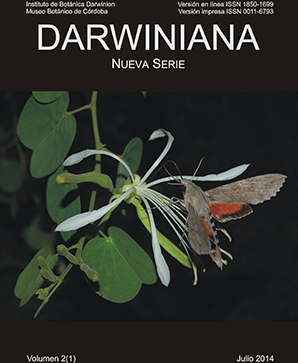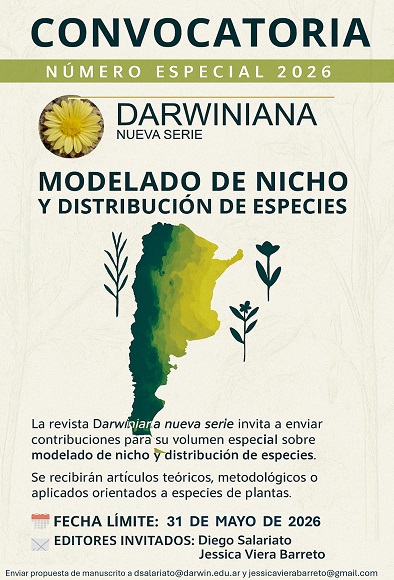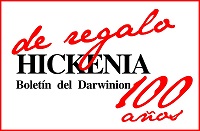DESARROLLO DE LA VARIANTE CAMBIAL EN SERJANIA MERIDIONALIS (SAPINDACEAE, PAULLINIEAE)
DOI:
https://doi.org/10.14522/darwiniana.2014.21.574Palabras clave:
Cilindros vasculares cordados, liana, Sapindaceae, Serjania, Sudamérica austral, variante cambial.Resumen
La familia Sapindaceae representa uno de los grupos de plantas trepadoras más importante del Neotrópico y presenta diversas variantes cambiales, algunas exclusivas. En esta contribución se describe el desarrollo del leño de Serjania meridionalis, la especie más austral del género, estudiado mediante técnicas anatómicas convencionales sobre la base de material proveniente de Isla Martín García (Buenos Aires, Argentina). El sistema vascular primario es eustélico. El crecimiento secundario se inicia con un cambium típico; sin embargo, con posterioridad, se desdiferencian meristemas de engrosamiento secundario supernumerarios. Estos meristemas producen nuevos cilindros vasculares (xilema y floema secundarios) en la periferia del cilindro vascular original. La presencia de cilindros vasculares cordados en los tallos añosos de S. meridionalis es novedad para la especie y plantea la necesidad de rever la dicotomía presencia-ausencia de variantes cambiales en muchas claves de identificación.
Citas
Acevedo-Rodríguez, P. 1993. Systematics of Serjania (Sapindaceae). Part I: A Revision of Serjania sect. Platycoccus. Memories of the New York Botanical Garden 67: 1-93.
Acevedo-Rodríguez, P. 2003. Bejucos y plantas trepadoras de Puerto Rico e Islas Vírgenes. Washington, DC: Smithsonian Institution.
Angyalossy, V.; G. Angeles, M. R. Pace, A. C. Lima, C. L. Dias-Leme, L. G. Lohmann & C. Madero-Vega. 2012. An overview on the anatomy, development and evolution of the vascular system of lianas. Plant Ecology & Diversity 5: 167-182. DOI: http://dx.doi.org/10.1080/17550874.2011.615574
Araújo, G. & C. Costa. 2006. Cambial variant in the stem of Serjania corrugata (Sapindaceae). IAWA Journal 27: 269-280.
Araújo, G. & C. Costa. 2007. Anatomia do caule de Serjania corrugata Radlk. (Sapindaceae). Acta Botanica Brasilica 21: 489-497. DOI: http://dx.doi.org/10.1590/S0102-33062007000200021
Bowling, A. J. & K. C. Vaughn. 2009. Gelatinous fibers are widespread in coiling tendrils and twining vines. American Journal of Botany 96: 719-727. DOI: http://dx.doi.org/10.3732/ajb.0800373
Cabanillas, P. A. & J. A. Hurrell. 2012. Plantas trepadoras: Tipo biológico y clasificación. Revista de Ciencias Morfológicas (La Plata) 14: 1-15.
Cabanillas, P. A.; M. L. Borniego & A. A. Sáenz. 2014. Nueva variante cambial para el género Ephedra (Ephedraceae). Boletín de la Sociedad Argentina de Botánica (Aceptado).
Carlquist, S. 1988. Comparative wood anatomy: systematic, ecological and evolutionary aspects of dicotyledon wood. Berlin: Springer. DOI: http://dx.doi.org/10.1007/978-3-662-21714-6
Dubuisson, J.-Y.; S. Hennequin, F. Rakotondrainibe & H. Schneider. 2003. Ecological diversity and adaptive tendencies in the tropical fern Trichomanes L. (Hymenophyllaceae) with special reference to climbing and epiphytic habits. Botanical Journal of the Linnean Society 142: 41–63. DOI: http://dx.doi.org/10.1046/j.1095-8339.2003.00165.x
Engelberth, J. 2003. Mechanosensing and signal transduction in tendrils. Advances in Space Research 32: 1611-1619. DOI: http://dx.doi.org/10.1016/S0273-1177(03)90402-9
Ferrucci, M. S. 1998. Sapindaceae, en A. T. Hunziker (ed.), Flora Fanerogámica Argentina fasc. 52 pp. 1-44. Córdoba: Programa Floras Regionales.
Ferrucci, M.S. 2004. Sapindaceae. Aportes Botánicos de Salta- Serie Flora 7: 1-53.
Ferrucci, M. S.; S. A. Cáceres Moral & M. Galbany Casals. 2002. Las plantas trepadoras, en M. M. Arbo & S. G. Tressens (eds.), Flora del Iberá, pp. 111-153. Corrientes: Eudene.
Fisher, J. B. & F. W. Ewers. 1991. Structural responses to stem injury in vines, en F. E. Putz y H. A. Mooney (eds.), The biology of vines, pp. 99-126. Cambridge: Cambridge University Press.
Gianoli, E. 2004. Evolution of a climbing habit promotes diversification in flowering plants. Proceedings of the Royal Society B: Biological Sciences 271: 2011-2015. DOI: http://dx.doi.org/10.1098/rspb.2004.2827
Garrido-Pérez, E. I.; R. Durán & G. Gerold. 2012. Las relaciones liana-árbol: repercusiones sobre las comunidades arbóreas y sobre la evolución de los árboles. Interciencia 37: 183-189.
Gentry, A. H. 1991. The distribution and evolution of climbing plants, en F. E. Putz y H. A. Mooney (eds.), The biology of vines, pp. 3-52. Cambridge: Cambridge University Press.
Hurrell, J. A. (ed.). 2006. Biota Rioplatense. V. Plantas trepadoras nativas y exóticas. 1ra. reimpresión, Buenos Aires: Editorial LOLA.
IAWA. 1989. List of microscopic features for hardwood identification. IAWA Bulletin 10: 219-332.
Johansen, D. A. 1940. Plant microtechnique. New York: Mc-Graw-Hill.
Klaassen, R. 1999. Wood anatomy of the Sapindaceae. IAWA Journal Suppl. 2: 1-214.
Krings, M.; H. Kerp, T.N. Taylor & E.L. Taylor. 2003. How Paleozoic Vines and Lianas Got off the Ground: On Scrambling and Climbing Carboniferous–Early Permian Pteridosperms. Botanical Review 69: 204-224. DOI: http://dx.doi.org/10.1663/0006-8101(2003)069[0204:HPVALG]2.0.CO;2
Lev-Yadún, S. & R. Aloni. 1993. Variant secondary growth in old stems of Ephedra campylopoda G. A. Mey. Botanical Journal of Linnean Society 112: 51-58. DOI: http://dx.doi.org/10.1111/j.1095-8339.1993.tb00307.x
Lorea, L. & M. Brassiolo. 2007. Establecimiento de lianas sobre los árboles de un bosque del Chaco Húmedo Argentino. Revista Forestal Venezolana 51: 47-55.
Metcalfe, C. R. & L. Chalk (eds.). 1983. Anatomy of the Dicotyledons, Vol. II: Wood Structure and Conclusion of the General Introduction, 2da. edición. Oxford: Clarendon Press.
Obaton, M. 1960. Les lianes ligneuses à structure anormale des forêtes denses d´Afrique Ocidentale. Annales des Sciences Naturelles, série Botanique et Biologie Végétal 12: 1-220.
Putz, F. E. & N. M. Holbrook. 1991. Biomechanical studies of vines, en F. E. Putz y H. A. Mooney (eds.), The biology of vines, pp. 73-98. Cambridge: Cambridge University Press.
Putz, F. E. & H. A. Mooney. 1991. The Biology of Vines. Cambridge: Cambridge University Press.
Radlkofer, L. 1931. Sapindaceae, en A. Engler (ed.), Das Pflanzenreich IV, 165, Heft 98a-h, pp. 1–1539. Leipzig: W. Engelmann.
Selaya, N. G. & N. P. R. Anten. 2008. Differences in biomass allocation, light interception and mechanical stability between lianas and trees in early secondary tropical forest. Functional Ecology 22: 30–39.
Schenck, H. 1893. Beiträge zur Biologie und Anatomie der Lianen, im Besonderon der in Brasilien einheimischen Arten. 2. Beiträge zur anatomie der lianen, in: Schimper, A.F. (ed.). Botanische Mittheilungen aus den Tropen 5. Gustav Fischer, Jena.
Schnitzer, S. A.; M. Kuzee & F. Bongers. 2005. Disentangling above- and below-ground competition between lianas and trees in a tropical forest. Journal of Ecology 93: 1115-1125. DOI: http://dx.doi.org/10.1111/j.1365-2745.2005.01056.x
Speck, T. & N. K. Rowe. 2003. Modelling primary and secondary growth processes in plants: a summary of the methodology and new data from the early lignophyte. Philosophical Transactions of the Royal Society of London B 358: 1473-1485. DOI: http://dx.doi.org/10.1098/rstb.2003.1347
Solereder, H. 1908. Systematic anatomy of the Dicotyledons. Vol. 1-2. Oxford: Clarendon Press.
Shirley, J. & C.A. Lambert. 1918. The stems of climbing plants. Proceedings of the Linnean Society of NSW 43: 600-609.
Tamaio, N. & V. Angyalossy. 2009. Variação cambial em Serjania caracasana (Sapindaceae): Enfoque na adequição terminológica. Rodriguésia 60(3): 651-666.
Tamaio, N. & G. V. Somner. 2010. Development of corded vascular cylinder in Thinouia restingae Ferruci & Somner (Sapindaceae: Paullinieae). Journal of Torrey Botanical Society 137: 319-326. DOI: http://dx.doi.org/10.3159/10-RA-047.1
Thiers, B. [permanentemente actualizado, consulta 2014] Index Herbariorum: a global directory of public herbaria and associated staff. New York Botanical Garden’s Virtual Herbarium. Disponible en http://sweetgum.nybg.org/ih
Archivos adicionales
Publicado
Cómo citar
Número
Sección
Licencia

A partir de 2012, esta obra está licenciada bajo una Licencia Creative Commons Atribución-NoComercial 2.5 Argentina .
Cualquier obra derivada deberá estar previamente autorizada con nota escrita de los editores.








